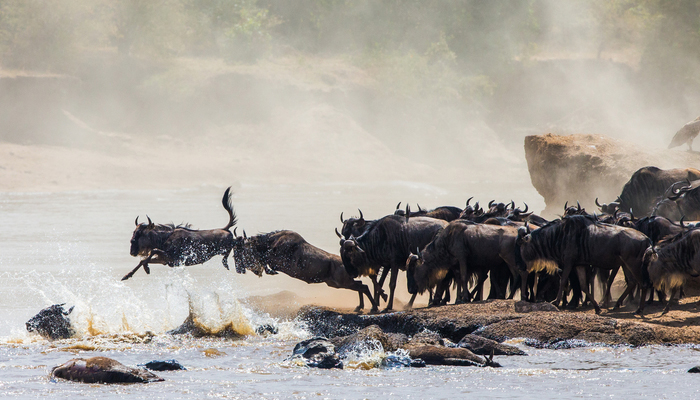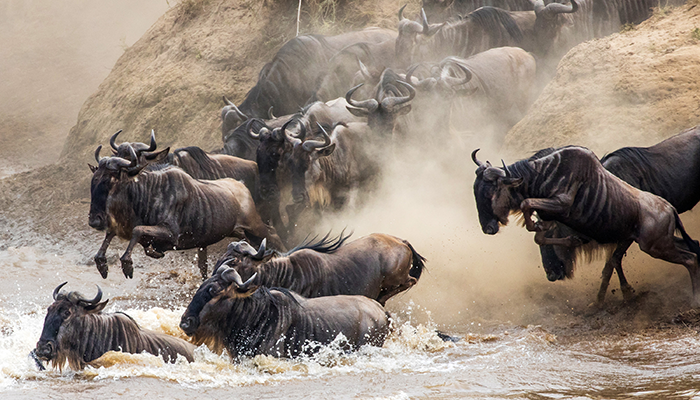
The Great Migration is an iconic occurrence in the great reserves of Tanzania and Kenya and inspires many questions. Happily, our resident Tanzania expert, Lana Byal, can answer them!
If some of these have been on your mind, keep reading, and then of course, start planning!
1. What is the Great Migration?
The Great Migration is the movement of a huge number of animals, including over 2 million wildebeest accompanied by large numbers of zebra, and smaller numbers of Grant’s gazelle, Thomson’s gazelle, eland and impala. These animals move in an annual pattern which is fairly predictable and covers over over 620 miles (1000 kilometers.) They follow the rains and traverse Tanzania’s Serengeti and Kenya’s Massai Mara (e.g. Serengeti-Mara Ecosystem) in search of the grasses they need to survive.
During this great journey, they must walk very long distances and simultaneously attempt to avoid predation from lions, cheetahs, leopards, and even hyenas and starvation. They must cross rivers filled with crocodiles waiting to catch a meal, battle disease, endure injury and fatigue and hopefully live to do it all again! As many as 250,000 animals will die during this yearly cycle.
Follow a live herd tracker: https://www.discoverafrica.com/herdtracker/

2. The Great Migration is a bucket-list item for so many people. Is it worth all the hype?
Absolutely! The Great Migration is an amazing phenomenon. It is stupendous to see hundreds of thousands of animals moving all together. Because so many animals rely on wildebeest and zebra for food, the Migration attracts many other species while moving through the landscape, making for unique sightings of diverse species. For example, on a good day, you can simultaneously watch giraffe, lion, elephant, buffalo, hippo, hyena, impala, zebra, ostrich, and gazelles.
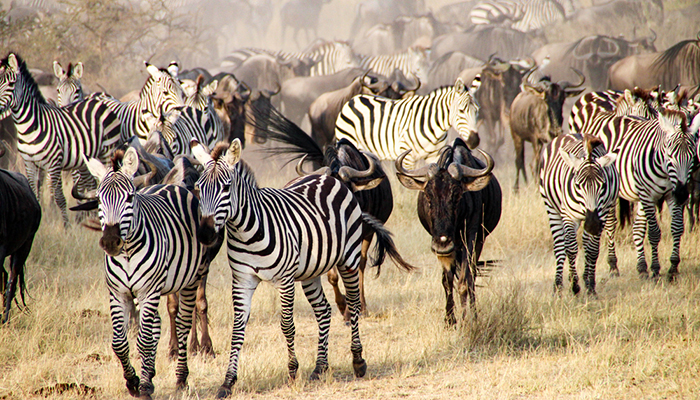
3. How do I enhance my Migration experience?
- Maximize your time in the Serengeti. Stay in at least two different camps in different locations to ensure the best chance of catching the migration in action.
- Plan ahead: if you can, give yourself at least 8-12 months (even over a year) in advance of when you’d like to travel. This way you can ensure getting the best lodges and camps in the most desirable locations.
- Seasonality: Think carefully about the experience you want vs. your dates of travel and budget. We can provide guidance to help you! Use a trusted resource and someone that is knowledgeable and passionate about the area to plan your trip.
- If you’re up for it, choose a more adventurous way to see the Migration! Go off the beaten path with a walking expedition across the Serengeti!
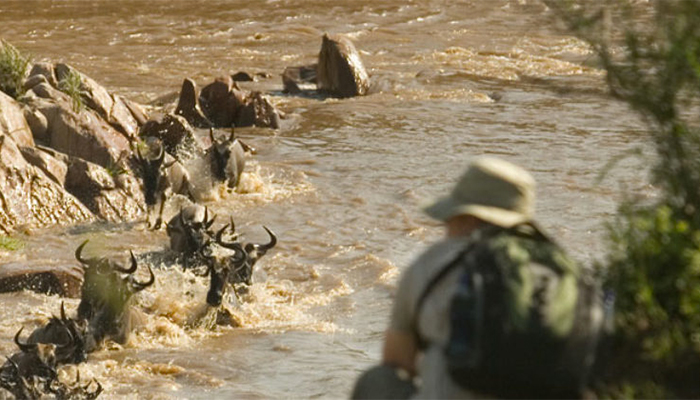
4. The movement of the wildebeest migration is kind of confusing. They’re covering a huge area, and it can be hard to understand their movements. How can you help travelers to plan around this?
That’s true, and we can do our best to plan for optimal destinations and dates, but in the end, nature depends on dynamic factors that are subject to change.
Since wildebeest and zebra are grazers, they’re following the grasses. They are chasing greener pastures all the time! And they have been really successful at this – maintaining a population of 1.5 millions animals. Zebra and wildebeest eat different parts of the same grass and therefore make excellent migration partners, which is why you see them together.
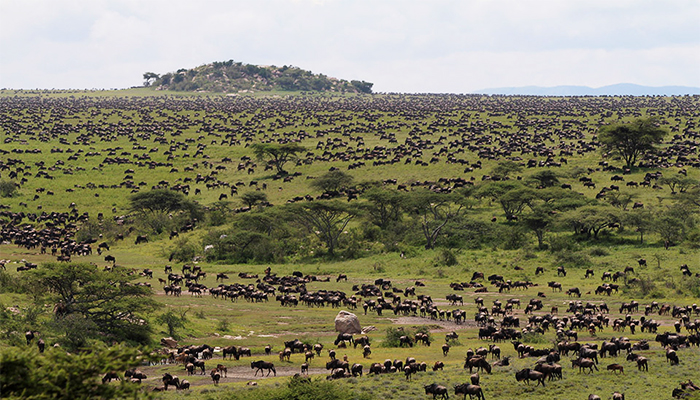
Plan your safari around the Migration Movements:
January-February
This is a fantastic time to go on safari in general and in particular to see plains game with their young. Many animals, including wildebeest, gazelle, zebra and impala have their young at this time and it’s common to see baby animals throughout the parks. This also draws predators to easy prey, in particular animals like cheetah and lion as they take advantage of the helpless young.
Generally, the migration is in the Southern Plains at this time and there are many great mobile tented camps and lodges to choose from. We know how to go into areas of the park and wilderness that will divert you from the crowds. Another great place to visit if you’re up for adventure and somewhere off the beaten path is Lake Natron. This is a phenomenal area with history, Massai culture and the towering, sacred mountain Ol Doinyo Lengai. The migration often makes its way through the Gol Mountains anytime between January and March.
March
The herds are still grazing across Serengeti’s short grass plains and also the Liondo and Ngorongoro Conservation Area. Rains begin in March, so the animals start to move.
April and May
These are WET months, and we advise not targeting the Serengeti as some roads can be impassable due to bad conditions and varying soil types. When safari vehicles try to avoid the bad roads and drive around the bad conditions, it damages the soils and grassland ecosystem. If you can only travel during this time, focus on Central Serengeti — Seronera Valley and Moru Kopjes. Only select lodges and camps will be in operation during this time, so your choice will be limited.
June through mid-July
The animals are on the move and are moving north through Seronera Valley in May and into the Western Corridor for June and July. They can still be dispersed, but large numbers of wildebeest are most often in the Grumeti Reserve and the Western Corridor of the Serengeti.
This is a place where it’s possible to see crossings over the Grumeti River (although not as impressive as the crossings at the Mara). Lodging is more dispersed in this region, and there are fewer camps and lodges overall. Since these months coincide with summer holidays, it’s very important to plan in advance. Some groups of the Migration will start to head north to the Mara River and follow the thunder showers.
Late July-October
Herds can move through the Northwestern regions of Serengeti National Park and even go outside of the park through buffer areas, such as Ikorongo. They will eventually end up in the Northern Serengeti in areas of the Lemai Wedge and Kogatende. Their main obstacle is crossing the Mara River over into Kenya, following the thunderstorms and green grazing opportunities. The north is a beautiful landscape dotted with large rock outcroppings, woodlands, and plenty of open space teeming with wildlife. This is spectacular place to catch the migration crossing the Mara River, which is both fascinating and hard to watch at times. Many animals perish here both to predation and injury. River crossings can last through September (when crowds fade), and the migration can still be seen grazing in the northern region of the park through October. However, many animals will also start heading south in October through the west (Loliondo) and Lobo areas, returning to the southern and central parts of the park in November.
November-December
Animals are dispersed in large groups among different areas – Southern Serengeti (Southern Plains), Loliondo, Ndutu, and Ngorongoro Conservation Area (including the Gol Mountain area). November and December can be a little rainy, but it’s green and lush and typically you can find animals in various areas. November safari rates are more advantageous because December is peak season and rates increase, particularly over the holidays.
Ready to book your own Migration safari? Get in touch with our expert safari designers, and we’ll plan your perfect adventure.
